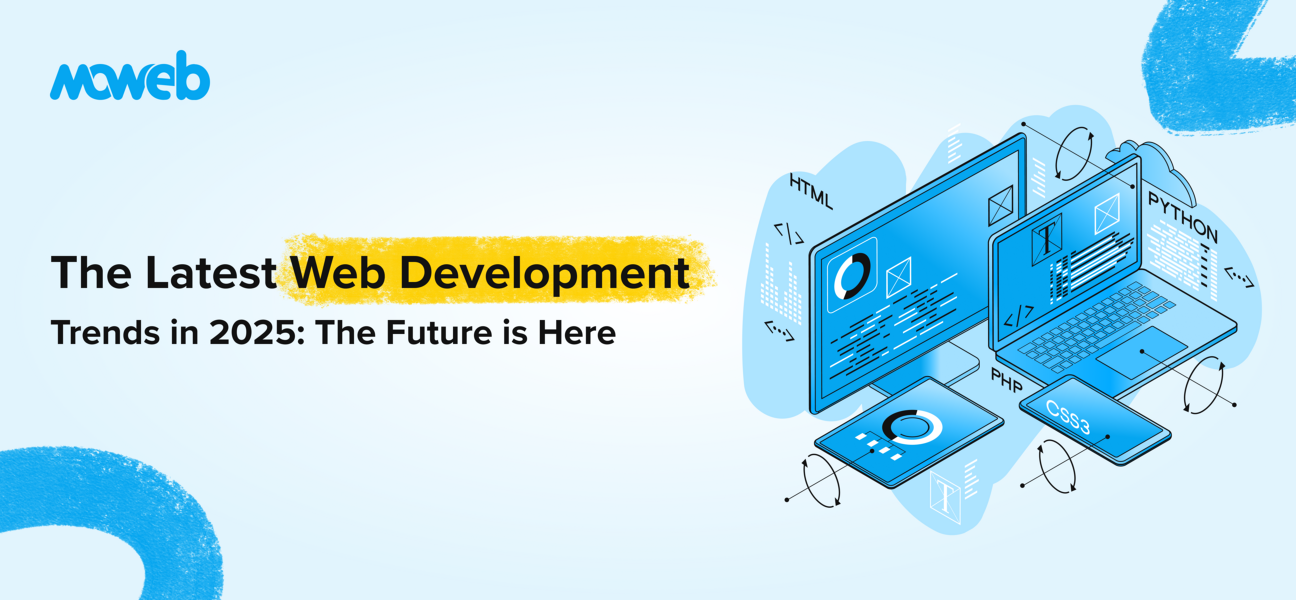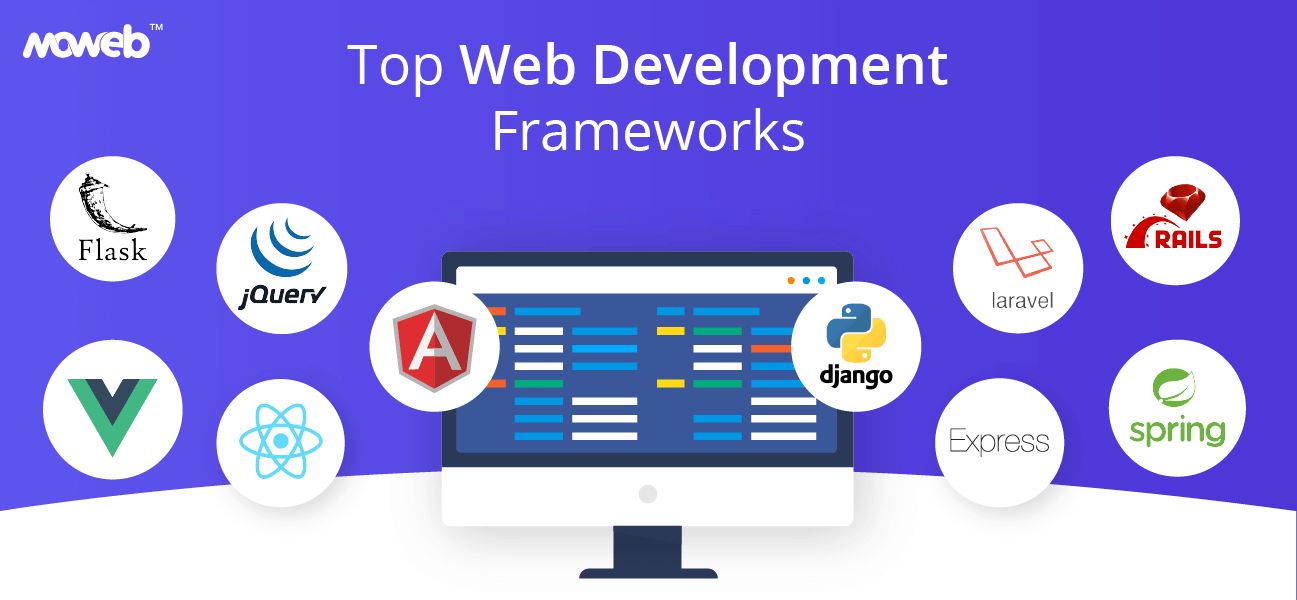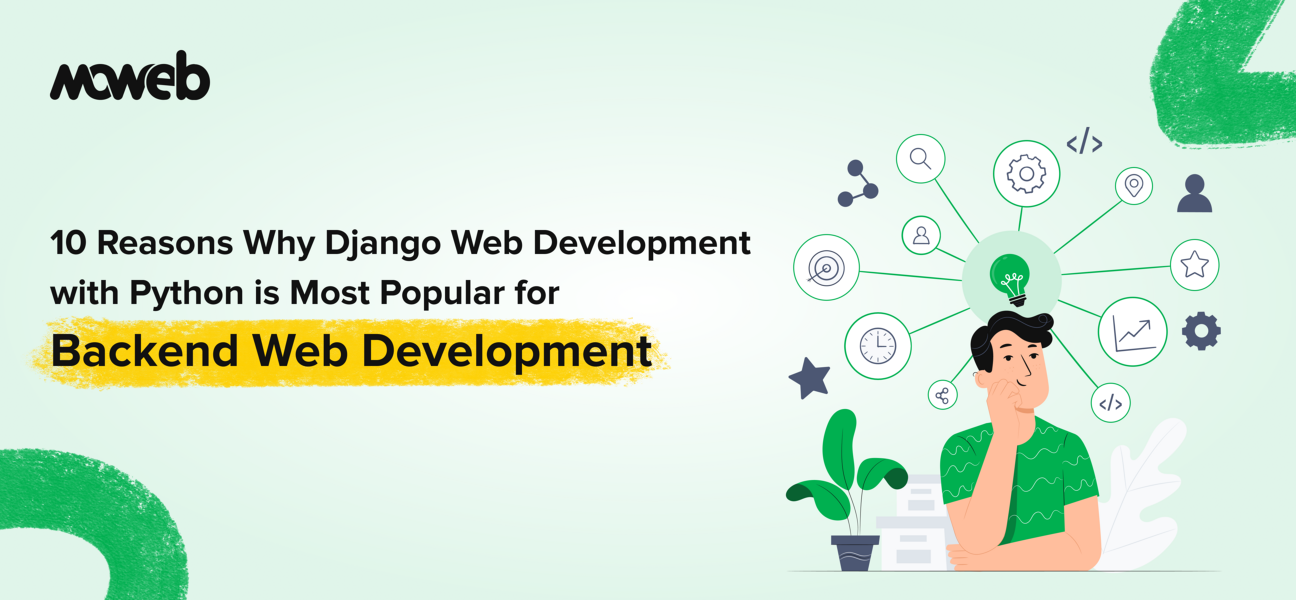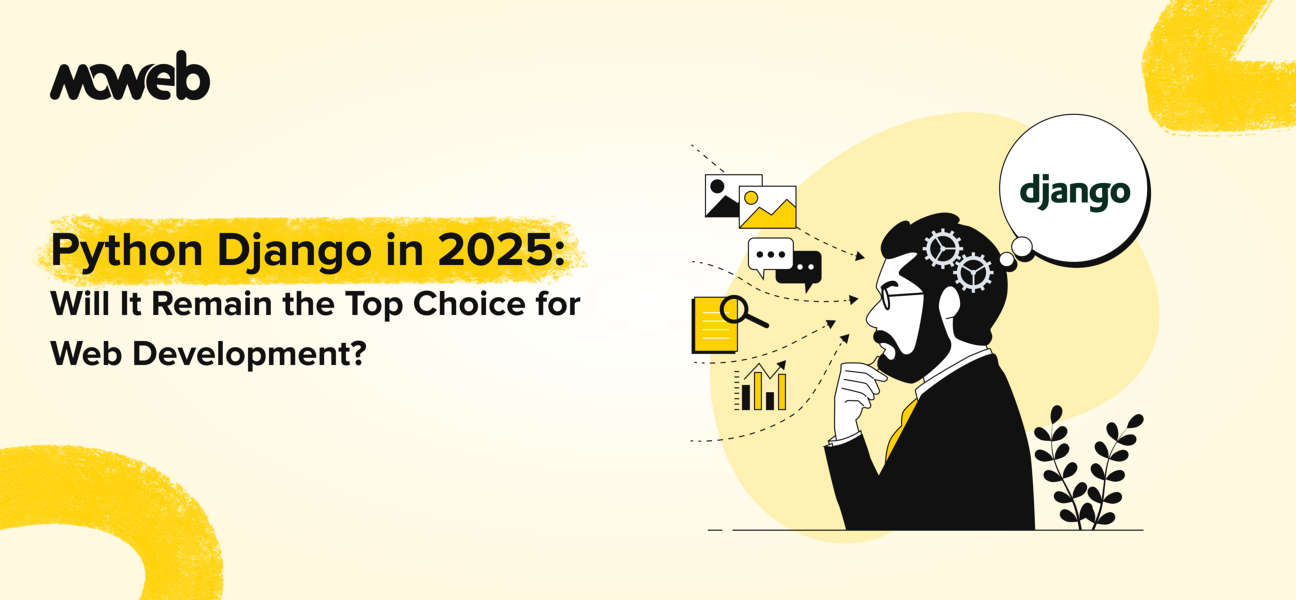
Overview
The web development landscape in 2025 is defined by innovation, efficiency, and user-centric designs. Businesses must adapt to trends like Progressive Web Applications (PWAs), voice search optimization, and WebAssembly (Wasm) to stay relevant. These advancements aren’t just buzzwords; they represent a fundamental shift in how websites are developed, maintained, and experienced by users. Developers now focus on delivering solutions that combine speed, security, and personalization to meet the growing expectations of modern audiences.
In the ever-shifting sands of technology, staying ahead of the curve is no longer a luxury—it’s a necessity. Web development, in particular, is a dynamic field that constantly evolves with new trends and advancements, transforming how businesses interact with their audiences. As we step into 2025, it’s crucial for developers and businesses to understand these changes to stay competitive.
The future of web development is being shaped by cutting-edge technologies like AI, serverless architecture, and AR/VR, creating opportunities for more engaging, efficient, and sustainable digital experiences.
This blog aims to provide a comprehensive guide to the top web development trends of 2025, offering actionable insights and strategies for businesses to leverage these advancements. In the coming years, over half of all internet searches will be voice-based. Likewise, more than 60% of users abandon websites due to unresponsive design.
Gain a clear understanding of how these trends can drive growth, improve user engagement, and ensure long-term success in an increasingly competitive market.
Top Web Development Trends in 2025
1. AI-Powered Web Development
Artificial Intelligence (AI) continues to redefine web application development, offering smarter, more efficient ways to create user-centric digital experiences. By automating tasks, personalizing content, and enhancing workflows, AI has become a cornerstone of modern web development services in 2025.
The Role of AI in Web Development
AI analyzes user behavior and generates insights to create highly personalized web applications. From automating code testing to deploying dynamic chatbots, AI empowers developers to deliver faster, smarter, and more engaging solutions.
Applications in 2025
- AI Chatbots: Deliver real-time, round-the-clock customer support with tools like ChatGPT.
- Content Personalization: Platforms like Adobe Experience Cloud tailor experiences based on user preferences.
- Design Assistance: Tools like Canva simplifies complex tasks, enabling faster design processes.
Benefits for Businesses
- Enhanced User Engagement: Personalized interactions boost satisfaction and retention.
- Faster Development: Automation reduces manual tasks, accelerating time-to-market.
- Data-Driven Decisions: Predictive analytics ensure businesses stay ahead of trends.
Real-World Example
Netflix leverages AI to analyze user preferences, offering personalized recommendations that enhance engagement and retention.
AI is not just a trend; it’s a transformative tool for web and app development. Businesses integrating AI into their web development services can deliver superior experiences and gain a competitive edge in today’s fast-paced digital landscape.

2. Progressive Web Applications (PWAs)
Progressive Web Applications (PWAs) are revolutionizing web application development by combining the functionality of native apps with the accessibility of traditional websites. As businesses seek cost-effective and high-performing solutions, PWAs continue to gain traction in 2025 for their ability to deliver seamless, fast, and reliable user experiences.
Why PWAs Are Gaining Traction
PWAs offer a unified platform experience, allowing businesses to eliminate the need for separate app development for iOS and Android. They leverage modern web technologies like service workers and manifest files to create apps that function offline, load quickly, and deliver native app-like performance.
Applications in 2025
- E-commerce Platforms: PWAs like Starbucks allow users to browse menus and customize orders offline, driving convenience and loyalty.
- Streaming Services: Spotify’s PWA ensures uninterrupted music streaming even with low connectivity.
- Travel & Hospitality: Booking platforms use PWAs to enable offline access to itineraries, enhancing customer satisfaction.
Benefits for Businesses
- Faster Load Times: PWAs reduce bounce rates by delivering instant, lag-free page loads.
- Offline Functionality: Users can engage with content even without an active internet connection, ensuring reliability.
- Cost Efficiency: Businesses save on the cost of developing separate native apps while reaching users across all platforms.
Real-World Example
Twitter Lite, a PWA, delivers a high-performance experience while reducing data usage by up to 70%, making it accessible to users in regions with limited internet connectivity.PWAs are a game-changer for website and app development, offering businesses the flexibility to deliver superior user experiences without the complexities of managing multiple platforms. As demand for seamless digital interactions grows, PWAs have become an indispensable tool for companies striving to stay relevant in 2025.
Related Post: Top 10 Web Development Frameworks 2025
3. Voice Search Optimization
As voice assistants like Alexa, Siri, and Google Assistant become increasingly embedded in our lives, voice search optimization has emerged as a critical component of modern web development trends. By 2025, voice-first interfaces are shaping how businesses connect with their audiences, emphasizing speed, convenience, and accessibility.
The Growing Importance of Voice-First Interfaces
Voice searches account for a significant portion of online interactions, with users seeking quick, conversational responses to their queries. The shift toward hands-free technology is driving businesses to adapt, ensuring that their websites and content are optimized for this evolving behavior.
Strategies to Optimize for Voice Search
- Focus on Conversational Keywords: Unlike traditional search, voice queries tend to be longer and more natural. Incorporating long-tail keywords into content ensures alignment with spoken language.
- Structured Data Markup: Implementing schema markup helps search engines understand and prioritize content for voice search results.
- Mobile and Speed Optimization: Voice searches are predominantly mobile-based. Websites need to load quickly and provide a seamless mobile experience.
- Answer Direct Questions: Create content that directly answers user questions in a concise, informative manner to increase the chances of being featured in voice search results.
Benefits for Businesses
- Enhanced Accessibility: Voice search makes digital platforms more inclusive, especially for users with disabilities.
- User Convenience: Hands-free operation provides a seamless and fast way for users to access information or perform tasks.
- Higher Engagement: Voice-optimized websites rank better in search engine results, increasing visibility and traffic.
Real-World Example
Domino’s Pizza integrates voice search into its app, allowing customers to place orders with voice commands. This innovation has boosted customer engagement and simplified the ordering process.
Voice search optimization is no longer optional—it’s essential for staying relevant in an increasingly voice-driven world. By embracing this trend, businesses can create frictionless, accessible, and highly engaging user experiences.

4. WebAssembly (WASM)
WebAssembly (WASM) is revolutionizing web application development by delivering near-native performance directly within web browsers. By allowing code written in various programming languages to run at blazing speeds, Wasm is setting a new benchmark for performance and user experience in web development trends for 2025.
Bringing Near-Native App Performance to the Web
Traditional JavaScript-based web applications often struggle with performance-heavy tasks. Wasm addresses these limitations by executing precompiled code, enabling web apps to handle demanding workloads like video editing, complex data visualization, and gaming. It opens doors for developers to create web applications that rival native apps in speed and functionality.
Applications in Key Industries
- Gaming: High-performance gaming platforms leverage Wasm to deliver smooth, immersive gameplay experiences directly in the browser.
- Video Editing: Real-time video processing tools powered by Wasm eliminate the need for bulky software downloads.
- Data Visualization: Financial and healthcare industries use Wasm to render intricate, dynamic visualizations without lag.
- AI and Machine Learning: Integrating Wasm enables AI models to run efficiently in-browser for applications like image recognition and analytics.
Benefits for Businesses
- Enhanced Performance: Wasm optimizes resource-intensive tasks, making web applications faster and more efficient.
- Cross-Platform Compatibility: Runs seamlessly across all major browsers, reducing development time and costs.
- Smoother User Experience: Eliminates delays and lag, providing users with a highly responsive and fluid interaction.
Real-World Example
Figma, a collaborative design platform, relies on Wasm to power real-time edits and handle complex design operations directly in the browser. This innovation has elevated its user experience, making it a favorite among designers worldwide.
WebAssembly is more than a performance enhancer—it’s a game-changer for businesses looking to push the boundaries of what web applications can achieve. Adopting Wasm is a strategic move to deliver cutting-edge, responsive, and versatile user experiences.
5. Serverless Architecture
Serverless architecture is transforming how web applications are built and managed, enabling businesses to focus on innovation rather than infrastructure. By outsourcing backend management to cloud providers, developers can streamline processes, improve scalability, and reduce operational costs. This approach makes serverless architecture a pivotal component of web development trends in 2025.
Revolutionizing Backend Development
Unlike traditional setups requiring dedicated servers, serverless architecture allows businesses to use backend services on an as-needed basis. This pay-as-you-go model ensures cost efficiency while automating infrastructure management, freeing developers to focus on creating feature-rich applications.
Key Tools Powering Serverless Architecture
- AWS Lambda: Provides automated execution of backend code, scaling seamlessly during traffic surges.
- Google Cloud Functions: Simplifies app development with real-time data processing and dynamic resource allocation.
- Microsoft Azure Functions: Offers a robust platform for building serverless workflows and automating complex tasks.
Applications Across Industries
- E-commerce: Enables dynamic pricing updates and real-time inventory management.
- Content Streaming: Powers scalable solutions for delivering high-quality video and audio to global audiences.
- IoT Devices: Handles real-time data processing from smart devices without latency issues.
- Chatbots: Provides efficient backend support for conversational AI applications.
Benefits for Businesses
- Cost Savings: Eliminates the need for maintaining physical servers, reducing hardware and operational costs.
- Scalability: Automatically adjusts resources to handle traffic spikes without performance lags.
- Reduced Maintenance: Cloud providers handle updates, security patches, and infrastructure monitoring.
- Quick Time-to-Market: Developers can deploy applications faster, focusing on innovation rather than setup complexities.
Real-World Example
Netflix utilizes serverless architecture to support billions of video streams daily. By leveraging AWS Lambda, Netflix ensures a seamless, scalable, and uninterrupted streaming experience for its global audience, even during peak times.
Serverless architecture is more than a cost-saving measure—it’s a strategic tool for enhancing agility, scalability, and efficiency in web development. For businesses aiming to remain competitive, adopting serverless solutions is a crucial step toward innovation.
6. Cybersecurity Best Practices
In 2025, cybersecurity remains at the forefront of web development trends, as businesses face an increasing number of sophisticated threats. Protecting user data, ensuring secure transactions, and maintaining compliance with global regulations are non-negotiable for organizations building robust web applications. Incorporating cybersecurity best practices into every stage of web application development is vital for fostering trust and safeguarding digital assets.
Securing the Web Landscape
As cyber threats grow in complexity, web developers must prioritize security from the ground up. Proactive measures such as encryption, secure authentication, and vulnerability testing ensure that applications remain resilient against breaches.
Key Vulnerabilities and Mitigation Strategies
- SQL Injection Attacks: Prevent by using parameterized queries and stored procedures to safeguard databases.
- Cross-Site Scripting (XSS): Implement content security policies (CSP) and validate user inputs to block malicious scripts.
- Cross-Site Request Forgery (CSRF): Protect by adding tokens to forms and validating user sessions.
- Man-in-the-Middle Attacks: Use SSL/TLS encryption to secure communication channels.
- Weak Passwords: Enforce multi-factor authentication (MFA) and educate users on password hygiene.
Compliance with Global Regulations
Adhering to legal frameworks like GDPR (General Data Protection Regulation) and CCPA (California Consumer Privacy Act) is essential for businesses operating in global markets. Secure development practices help organizations avoid legal repercussions while enhancing user trust.
Benefits of Secure Web Development
- Enhanced User Trust: Customers feel confident sharing sensitive information when they know their data is secure.
- Regulatory Compliance: Meet international standards and avoid costly penalties associated with breaches.
- Brand Reputation Protection: Safeguard your business’s reputation by preventing high-profile security incidents.
- Operational Continuity: Avoid downtime and data loss caused by cyberattacks.
Real-World Example
Slack, a leading communication platform, implements robust end-to-end encryption and regular penetration testing to protect its millions of daily users. By prioritizing cybersecurity, Slack ensures uninterrupted service and user data confidentiality.
Cybersecurity is no longer optional—it’s a fundamental aspect of modern web development. As threats continue to evolve, businesses must adopt a proactive, layered approach to security to protect their users and maintain their competitive edge.

7. Sustainable Web Development
As businesses and users grow more environmentally conscious, sustainable web development is emerging as a significant trend in 2025. The digital world consumes massive amounts of energy, but adopting eco-friendly design practices and leveraging green hosting solutions can reduce the environmental impact of websites and applications. Sustainable web development is not just a technological choice—it’s a commitment to a greener future.
Driving Sustainability in Web Development
Sustainable web development focuses on reducing energy consumption, optimizing website performance, and utilizing environmentally friendly infrastructure. This trend encourages developers to create efficient, lightweight websites that minimize server loads and prioritize energy savings.
Core Practices for Sustainable Web Development
- Eco-Friendly Hosting Solutions
Use hosting providers powered by renewable energy sources to reduce carbon footprints. Platforms like GreenGeeks and Google Cloud promote sustainability with their clean energy commitments. - Efficient Code and Optimized Assets
Write clean, optimized code and compress assets like images and videos to decrease server load and energy consumption. - Static Websites
Adopt static site generators for content delivery. These require fewer resources than dynamic sites, reducing energy usage. - Reduced Data Transfer
- Minimize resource-heavy features like autoplay videos and large animations, ensuring faster load times and lower data transfer costs.
Benefits of Sustainable Web Development
- Environmental Impact Reduction: Contribute to lower energy consumption and fewer carbon emissions.
- Enhanced Performance: Lightweight designs improve website load times and user experience.
- Attracting Conscious Users: Eco-friendly practices appeal to a growing base of environmentally aware consumers.
- Cost Efficiency: Reducing server loads and data transfer requirements leads to lower operational costs.
Real-World Example
Wholegrain Digital, a digital design agency, actively measures the energy consumption of its website, ensuring it operates sustainably. By leveraging optimized hosting and efficient designs, the company sets a benchmark for eco-friendly web development.
The push toward sustainability reflects a broader societal shift toward environmental responsibility. By embracing sustainable web development, businesses align their digital presence with the values of their environmentally conscious audience.
8. Low-Code/No-Code Platforms
The emergence of low-code/no-code platforms is democratizing the web development landscape, empowering non-technical users to create functional and visually appealing applications. These platforms bridge the gap between developers and non-developers, enabling faster, more efficient development processes without requiring extensive coding knowledge.
The Power of Low-Code/No-Code Development
Low-code and no-code platforms offer intuitive, drag-and-drop interfaces for building websites and applications. They simplify complex workflows, making them accessible to businesses looking to prototype, develop internal tools, or launch Minimum Viable Products (MVPs) quickly and cost-effectively.
Use Cases Driving Adoption
- Prototyping for Startups: Quickly design and test MVPs, saving time and resources during early development phases.
- Internal Business Tools: Create custom dashboards, task managers, and other productivity-enhancing tools without coding expertise.
- Small-Scale Applications: Build lightweight apps for specific needs, such as event registration platforms or survey tools.
Benefits of Low-Code/No-Code Platforms
- Faster Development Cycles: Accelerates application development with pre-built components and easy-to-use interfaces.
- Cost Efficiency: Reduces reliance on professional developers, making it budget-friendly for startups and small businesses.
- Empowered Teams: Allows marketing, operations, and HR teams to build tailored tools without waiting for IT support.
- Improved Collaboration: Developers and non-developers can collaborate seamlessly, aligning technical and business goals.
Real-World Example
Zapier, a no-code automation platform, enables businesses to automate workflows without writing a single line of code. By integrating apps like Gmail, Slack, and Trello, Zapier boosts productivity across teams with minimal technical effort.
Low-code and no-code platforms aren’t just tools—they’re catalysts for innovation. They enable businesses to respond swiftly to market demands, prototype new ideas with ease, and empower teams to take ownership of their solutions.
9. AR/VR Integration
Augmented Reality (AR) and Virtual Reality (VR) are revolutionizing web development, offering immersive, interactive experiences that redefine how users engage with digital content. By integrating AR/VR into websites and applications, businesses are unlocking new possibilities for personalization, visualization, and user interaction.
The Role of AR/VR in Web Development
AR overlays digital elements onto the real world, while VR immerses users in entirely virtual environments. Together, they enable businesses to offer engaging experiences that were once limited to high-end technologies.
Applications of AR/VR in Web Development
- Virtual Product Try-Ons: E-commerce platforms use AR to let customers visualize products, such as clothing or furniture, before purchasing.
- 3D Walkthroughs: Real estate websites provide immersive virtual tours of properties, giving users a sense of space and layout.
- Enhanced Learning Experiences: Educational platforms use VR to create interactive environments for hands-on training or exploration.
- Gamified Experiences: AR/VR elevates gaming by integrating real-world environments with virtual gameplay.
Benefits of AR/VR Integration
- Enhanced User Engagement: Immersive experiences captivate users, keeping them on your platform longer.
- Increased Conversion Rates: By offering visualizations like product try-ons, users are more likely to make confident purchasing decisions.
- Differentiated Branding: AR/VR helps brands stand out in competitive markets by delivering unique, cutting-edge experiences.
- Improved Customer Retention: Interactive content fosters deeper connections, encouraging users to return.
Real-World Example
IKEA Place, an AR app, allows users to visualize how furniture will look and fit in their homes. By blending AR with e-commerce, IKEA has enhanced customer confidence and streamlined the decision-making process.
As AR/VR technologies become more accessible, their integration into websites and applications is no longer a novelty—it’s an expectation. Industries such as retail, real estate, education, and entertainment are leveraging AR/VR to provide dynamic, interactive experiences that redefine user expectations.
10. Micro-Frontend Architecture
Micro-frontend architecture is transforming web application development by dividing large, complex applications into smaller, manageable, and independently deployable components. This approach streamlines the development process, making it more efficient and scalable, especially for enterprise-level projects.
What is Micro-Frontend Architecture?
Micro-frontend architecture extends the microservices concept to the frontend, allowing different teams to work on various parts of an application independently. Each “micro-frontend” represents a self-contained piece of the user interface, designed and deployed separately, yet seamlessly integrated into the larger application.
Benefits of Micro-Frontend Architecture
- Enhanced Team Efficiency: Multiple teams can work on different components simultaneously without waiting for dependencies, speeding up development cycles.
- Easier Scalability: New features or modules can be added as standalone components, making it easier to scale the application as business needs evolve.
- Improved Maintenance: Smaller, independent components are easier to debug, test, and update without impacting the entire application.
- Technology Agility: Teams can use different technologies for different components, enabling flexibility and future-proofing the application.
Applications of Micro-Frontend Architecture
- E-Commerce Platforms: Divide features like product catalogs, user accounts, and payment gateways into separate components for independent updates and testing.
- Enterprise Portals: Enable diverse teams to manage individual modules like dashboards, reporting tools, and communication systems.
- SaaS Applications: Allow feature teams to deploy updates to specific modules without affecting the entire user interface.
Real-World Example
Spotify leverages micro-frontend architecture to deliver a seamless experience by allowing independent deployment of features like playlists, recommendations, and user settings. This modularity ensures that changes to one feature don’t disrupt the rest of the application.
Impact on Web Development
As web applications grow more complex, the need for modular and maintainable architectures becomes crucial. Micro-frontend architecture not only addresses this challenge but also enhances collaboration among development teams, resulting in faster delivery and more robust applications.
Embrace the Future of Web Development
The web development trends of 2025 highlight the industry’s shift toward smarter, faster, and more sustainable solutions. By leveraging these advancements, businesses can stay ahead of the curve, delivering unparalleled user experiences and driving growth.

FAQs
1. What are the top web development trends in 2025, and how can they impact businesses?
The top web development trends in 2025 include AI-powered web development, Progressive Web Applications (PWAs), voice search optimization, WebAssembly (Wasm), serverless architecture, and AR/VR integration. These trends enable businesses to build faster, smarter, and more secure websites while delivering personalized and immersive user experiences. By adopting these advancements, companies can enhance customer engagement, streamline operations, and gain a competitive edge in the digital marketplace.
2. Why is WebAssembly (Wasm) a game-changer for modern web applications?
WebAssembly (Wasm) revolutionizes web applications by enabling near-native performance within browsers. This technology allows developers to run code written in multiple programming languages directly on the web, making it ideal for resource-intensive applications like video editing, real-time data visualization, and high-performance gaming platforms. By adopting WebAssembly, businesses can offer seamless and responsive user experiences, reduce app loading times, and improve customer satisfaction, especially for demanding applications.
3. How do Progressive Web Applications (PWAs) benefit businesses in 2025?
Progressive Web Applications (PWAs) combine the best features of websites and native apps, offering faster load times, offline capabilities, and seamless performance across devices. PWAs are cost-effective and reduce the need for separate iOS and Android apps. For businesses, PWAs improve user retention, boost engagement, and support better search engine visibility. For instance, major brands like Starbucks and Twitter Lite have successfully adopted PWAs to enhance customer experiences, leading to higher conversions and improved loyalty.
4. What are the key benefits of serverless architecture for web development?
Serverless architecture eliminates the need for maintaining traditional servers, allowing businesses to focus on development while cloud providers handle the infrastructure. This approach offers cost savings, instant scalability, and reduced maintenance overhead. With tools like AWS Lambda and Google Cloud Functions, businesses can deploy applications more efficiently and handle traffic surges without performance issues. By leveraging serverless setups, companies can build dynamic, scalable websites and applications that adapt to ever-changing market demands.
5. Why is cybersecurity a critical trend in web development for 2025?
As cyber threats become more sophisticated, cybersecurity in web development is a necessity. Features like end-to-end encryption, multi-factor authentication, and secure coding practices ensure user data protection and compliance with global regulations like GDPR and CCPA. Implementing robust cybersecurity measures enhances user trust and reduces the risk of costly breaches. In industries like e-commerce and finance, secure web development ensures seamless transactions, protecting both businesses and their customers from potential vulnerabilities.
Found this post insightful? Don’t forget to share it with your network!





